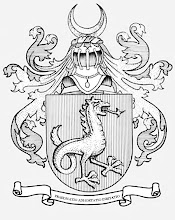
Up until a couple of years ago, all ISBNs were 10-digit.
Let's take the ISBN for How Do Dinosaurs Say Goodnight:
0-5903-1681-8
The first digit tells you what language the book was published in. A zero or a one means English. (The ISBN for Bonne Nuit Petit Dinosaure is 2-0705-5568-2. The first digit, a two, means it's in French.
 )
)The next four digits tell you the publisher. 5903 is one of the codes for Scholastic.
The next four digits are a random series of numbers, unique to the book.
The last digit is a check digit. In any computer set up for ISBNs, the computer can run through a mathematical calculation using the check digit to be sure there isn't an error in the previous series of numbers.
(If you're curious, you multiply the first digit by ten, the second by nine, the third by eight, the fourth by seven, the fifth by six, the sixth by five, the seventh by four, the eighth by three, the ninth by two. Then add all those products together. In the case of 0-5903-1681-8, you'd end up with 190. Then you ask yourself how much you would have to add to 190 to make it a multiple of eleven. The answer, and thus the check digit, is eight.)
(If the answer were ten, then the check digit would be the letter X.)

A couple of years ago, it started to look like we might run out of unique ISBNs, so the whole world switched to 13-digit ISBNs, which was accomplished by keeping all the 10-digit ISBNs, but adding 978 at the beginning. (Of course this necessitated a different check digit.)
The barcode shown here has two parts. The big barcode will tell a scanner the ISBN, which you'll see printed in its 10-digit form and 13-digit form above the barcode, and in its 13-digit form again under the barcode.
The little barcode will tell a scanner the price. You'll see the price printed twice above the little barcode: once with a $ in front of it, and once with a 5 in front of it. (5 is code for US dollars.)




16 comments:
I don't know that I have much to say about the definitions, except this is very cool. I love this information. Thanks!
Wow. Who comes up with this stuff?
Am I the only one who is annoyed that some of the places where you search books online only have a 10 digit entry system... while some of the books now only show the 13 digit number? And you can't simply cut off the first three numbers because the check digit is different...
I suppose I could run through that formula to figure out the proper check digit... but I have a headache, and that task does not seem like it will offer a cure.
Best to all,
Bryan Russell
super cool
I love all of your Definitions for the Perplexed---thank you for taking the time to inform us!
I’m starting to feel like a true-blue nitty-gritty book savvy Anonymati!
Say that 5x without tripping up . . .
Great info!
If you're linking to a book on Amazon.com using your affiliate identifier, the search only works using the 10-digit ISBN. Presumably they will get around to updating this one day!
fascinating.
That's genuinely fascinating. I never knew the formula to create a check digit before.
But I gotta know: Did you know all that, or did you have to research some of that math business? Maybe run over to production and ask around a little? Hm?
Hate to disappoint you, but I did know it off the top of my head.
I looked it up when I first started in publishing. ;)
I'm embarrassed to say I've been a bookseller for 2 1/2 years and only knew about the first digit rule and had no idea about the scanner. Great, interesting info.
Thanks!
Thanks so much! These definitions were great!
This was a fun one!! Thanks for explaining it!
:-)
On the contrary, EA, I am not disappointed, simply further in awe!
Thank you for explaining that. I know these rules as a librarian, but I've met an amazing number of book professionals, including booksellers, who have no idea what the components of an ISBN mean.
One small correction, if I'm not mistaken: the first digit indicates not the language of the book, but the principal language of the publisher. If a US or UK publisher were to publish a one-off book in French, they'd still use their 0- or 1- code. (Possibly some bilingual publishers, e.g. in Canada, have separate codes for their different language lines, but that doesn't affect the general rule.)
For those who don't want to do the math (whatever it turns out to be!), there's an online ISBN converter at http://www.isbn.org/converterpub.asp
Post a Comment